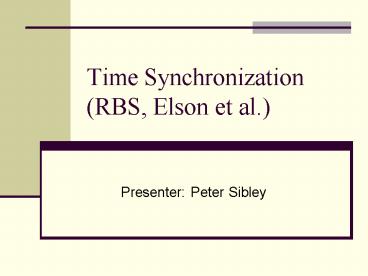Time Synchronization RBS, Elson et al. - PowerPoint PPT Presentation
1 / 22
Title:
Time Synchronization RBS, Elson et al.
Description:
... attached to a external clock. ... Reference Clock: GPS ,Atomic Clock. Stratum 1. Stratum ... receivers records the arrival times according to their local clock ... – PowerPoint PPT presentation
Number of Views:65
Avg rating:3.0/5.0
Title: Time Synchronization RBS, Elson et al.
1
Time Synchronization (RBS, Elson et al.)
- Presenter Peter Sibley
2
Traditional Synchronization Methods
- Server sends messages to client, containing
servers current time. - Common extension
- Client requests time from server
- Server sends current time.
- Client estimates one-way latency from the
round-trip time.
3
NTP
- (1-50ms) accuracy, most common time protocol.
- Uses hierarchy attached to a external clock.
- At the LAN level, workstations may use
information from peers .
Reference Clock GPS ,Atomic Clock
Stratum 1
Stratum 2
Stratum 15
See http//www.eecis.udel.edu/mills/ntp.html
4
Sources of Error
- Send Time
- Constructing message
- Variable OS delays in moving message to the
interface - Access Time
- Waiting to transmit message. (depends on MAC)
- Propagation Time
- To time get to receivers interface
- Receive Time
- Time for interface to generate a message
reception signal
5
Observations (Elson et al.)
- Try to remove send/access time errors.
- Synchronize among receivers.
- Relative time is more important.
- Latency is less of an issue, determinism is what
matters.
6
Example Phase Est.
- Node i at (0,0) is triggered at t4.
- Node j at (0,10) is triggered at t5.
- The moving object has velocity (0,10).
- Notice, no reference to a global time scale.
7
Estimation of Phase
- A transmitter sends m reference packets
- Each of the n receivers records the arrival times
according to their local clock - The receivers exchange their observations
- Receiver i computes phase offset to another other
receiver j as average offsets.
8
Phase-Estimation Simulation Results
9
Estimation of Clock Skew
- Each devices crystal oscillator, has slightly
different frequency. - Frequency of each oscillator varies over time.
- Use Least-Squares fit, instead of averaging phase
offsets. - Assumes phase error changes at a constant rate
10
Implementations
- Mote
- Tested 5 motes, with periodic reference pulse.
- 2 micro-sec resolution clock
- Ipaq running linux 2.4, 802.11 wireless
- Userspace Unix daemon.
- Use UDP.
11
Results (Mote)
12
Results
13
Multi-hop extension (example)
14
Multi-hop algorithm
15
Performance of multihop extension
16
Information Driven Dynamic Sensor Collaboration
for Tracking Applications, Zhao et al.
- Presenter Peter Sibley
17
Scenario
18
Collaborative Tracking.
19
Sequential Bayesian Estimation
- Problem Picking the next sensor, should be local
choice. - Need to Pick the neighbor sensor that will
improve the estimation the most. - Rephrase as an optimization problem,
- Objective is Mixture of Information Gain and Cost
20
Utility/Cost.
- Different Utility functions can be used
- Mahalanobis Distance
- Entropy Based
- Estimated Likelihoods
- (Depends on distributional assumptions)
- Costs
- Euclidean and weighted Euclidean distance from
the leader node.
21
Tracking Results
22
Tracking Results































